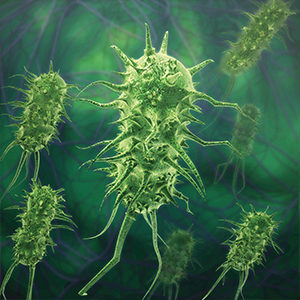Hand-foot-mouth disease is a common, mild viral illness of humans. The disease causes fever, blister-like sores in the mouth, and a skin rash. In the U.S., it is most commonly caused by a coxsackievirus, which is part of a larger group of viruses called enteroviruses.
HFMD typically affects children under the age of five. Adults may sometimes become infected with the virus. HFMD is most common in children in childcare settings because of frequent diaper changes and potty training, and because little children often put their hands in their mouths.
HFMD is not transmitted to or from pets or other animals.
Initial symptoms of HFMD include fever, poor appetite, a general feeling of being unwell, and sore throat. One or two days after fever starts, painful sores often develop in the mouth. They begin as small red spots that blister, often becoming ulcers. Next, a non-itchy rash with flat or raised red spots, sometimes with blisters, will develop over one to two days. The rash typically appears on the palms of hands and bottoms of feet and can also appear on the knees, buttocks, elbows or genital area. Persons infected with the viruses that cause HFMD may not get all the symptoms. They may only get mouth sores or skin rash.
The incubation period for HFMD is three to seven days. Fever is the first symptom to appear.
HFMD is moderately contagious and is spread from person to person by direct contact with nose and throat secretions (such as saliva, sputum or nasal mucus), fluid from blisters, and stool (feces) of the infected person. The virus may be spread when infected persons touch objects and surfaces that are then touched by others.
People infected with the virus are most contagious during the first week of their illness. The virus that causes HFMD can remain in the body for weeks after a person’s symptoms have gone away. This means infected people can still pass the virus to others even though they appear well. Also, some infected people, including most adults, may have no symptoms but still shed the virus.
Infection results in immunity to the specific virus that caused HFMD. A second case of HFMD may occur following infection with a different type of enterovirus.
Complications from HFMD are uncommon. They can include viral (aseptic) meningitis and encephalitis (inflammation of the brain).
There is no specific treatment for HFMD. Over-the-counter medications can be useful for fever and mouth pain.
There is no vaccine available for hand-foot-mouth disease.
Good hand washing is important to reduce the spread of HFMD. Children and adults should use proper hand hygiene, especially after using the toilet and changing diapers.
Excluding children from school and child care during the first few days of the infection will reduce the spread of the virus. In home and child care settings, thorough cleaning and disinfection of contaminated surfaces and items with a diluted bleach solution (1 part bleach to 10 parts water) is an effective way to reduce the spread of viruses.

Epidemiologists monitor, track, and respond to infectious disease in the community to prevent spread of illness.

Working with providers on the incidence, distribution, and possible control of diseases, illnesses and other factors relating to health.